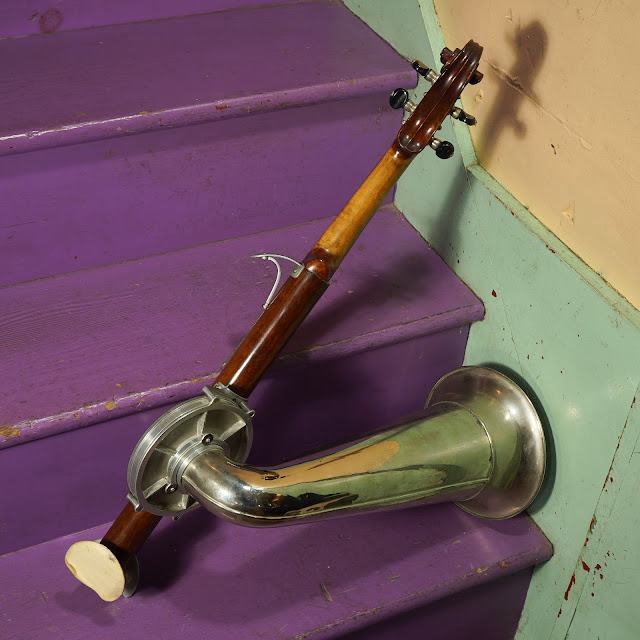1910s Strohviols 5/4 "Stroh Violin" or "Phonofiddle" Resonator Violin
This is a rare, fantastic instrument and made in England. While there are reproductions of this type of resonator fiddle available, the original article is a lot harder to find and this one is in excellent shape as well. The earliest versions used a smaller resonator design (some of them mica or flat aluminum) but this one has one that's about the size and conical shape of the style used in National Tricone guitars.
It has an interesting, cast housing that the resonator is installed in that allows for a brass-style horn to be mounted in such a way that it can be made to either "lock" in one position or remain loose-enough to rotate freely as desired.
Andy did all of the setup and playing-side work on this -- fitting a new bridge, planing the fingerboard, and installing a spare set of older Grover 1:1 friction pegs at the headstock. I tackled the troublesome resonator. The bridge is on sort-of a hinge where its center balances on a pivot on the violin itself and the treble foot of the bridge rests on an arm that runs down and connects to a post that runs into the resonator.
Said post is supposed to be "tensioned" to the cone by the string pressure and a little spring-aluminum clip on the back side of the resonator. This wasn't working very well at all and was making an accurate setup difficult. I changed the nail-like "post" (which was surrounded by a wooden dowel) to a long, thin screw that could be tightened as-desired from the inside of the resonator and so keep the connection to the "arm" coming off of the bridge foot rugged.
What I found then is that it worked a lot better but sound still dropped-out now and then. The solution to that was to fit a wooden sleeve (in this case, soundpost material) over the threads of the screw/post. I drilled the center out so it would fit over the screw but have enough "grab" that the threads would let it function like a nut. I used this wooden sleeve to tighten-down the "post"on the resonator side so it couldn't jostle-around and lose good contact with the resonator.
After all of this was done, the instrument was sounding just like it should -- full and warm but with a brassy bark to it. The sound is maybe not insanely louder than a good traditional fiddle but it projects much better and has a very directional sound. It actually hurts the ears to be close to the receiving end of this when it's being played.
One last curiosity, by the way, is the scale length -- as I recall (it's since sold), it has a longer scale length of about 14 1/4" or so. It is unclear whether this was intended as a shorter-scale viola or a longer-scale violin or if the builder simply mounted the bridge mechanism "there they felt like" rather than for its familiarity to the 13" scale of most violins. Anyhow, I'm calling it a 5/4 violin because of it.















Comments